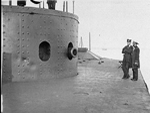At a Glance
Teacher Review
Topics
Website
Features
Duration
Grade(s)
Lesson Format
Download
Civil War Photos: What Do You See?
This lesson guides students through close analysis of a photograph of a piece of Civil War artillery as a means of better understanding the relationship between the Civil War and industrialization.
Review

This lesson provides an excellent opportunity to teach students how to analyze historical photographs. Focusing on one photograph of a piece of Civil War artillery (though making use of a variety of other images), the lesson guides students step by step in carefully analyzing various elements of the photograph. Different portions of the image are isolated, and students answer questions about details in that portion of the image. Some questions may be difficult for students, and even teachers, to answer on their own, but answers to the questions are provided. This portion of the process would be a great opportunity for teachers to encourage students to make educated guesses in response to the more difficult questions before checking their answers.
While the lesson focuses on one particular photograph, it includes a remarkably useful collection of Civil War photographs to provide context for the featured image. We especially like the encouragement given students to re-evaluate their conclusions about the first image after looking at subsequent pictures. Openness to new evidence and new conclusions is an attitude that is important for students of history to maintain.
In addition to being a great lesson for teaching close analysis, this lesson also provides an excellent link between a single source and a much larger theme. It bridges two important topics in American history—the Civil War and Industrialization. The lesson concludes with a class discussion surrounding a set of questions about how the process of industrialization influenced the way in which the Civil War was waged. So often in our classrooms, historical events and themes turn into discrete, isolated units; this lesson provides a valuable reminder that all of the periods and events we study are interconnected: students have the opportunity to see how industrialization influenced the process and outcome of the war, and perhaps even how the war in many ways drove industrialization.
Notes
This lesson may be conducted by the teacher using the “Teacher Materials” section of the site, or students may work independently in the “Student Lesson” section of the site; both sections of the site provide the same materials and activities.
| Field | Criteria | Comments | ||
|---|---|---|---|---|
| Historical Content | Is historically accurate? | Yes |
||
| Includes historical background? | Yes |
|||
| Requires students to read and write? | Yes |
|||
| Analytic Thinking | Requires students to analyze or construct interpretations using evidence? | Yes |
||
| Requires close reading and attention to source information? | Yes |
|||
| Scaffolding | Is appropriate for stated audience? | Yes |
||
| Includes materials and strategies for scaffolding and supporting student thinking? | Yes |
|||
| Lesson Structure | Includes assessment criteria and strategies that focus on historical understanding? | No |
||
| Defines clear learning goals and progresses logically? | Yes |
|||
| Includes clear directions and is realistic in normal classroom settings? | Yes |
|||